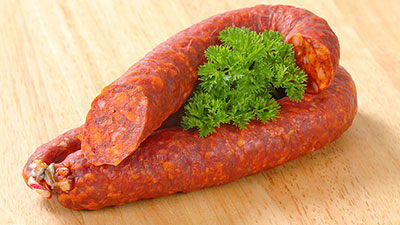Meats and Sausages
Longaniza Navarra - Traditional
Longaniza is a Spanish semi-dry or dry sausage originating in Navarra region of Spain. The following sausage recipe is for traditional Longaniza Navarra made without nitrates or fermenting starter cultures. When the atmospheric conditions (temperature, humidity, wind) did not favor production of dry sausage, the semi-dry sausage will be kept in casks filled with oil or lard. Today, of course, the sausage will be kept in refrigerator. Different cuts of meat can also be used, for example lean shoulder, front part of loin and back fat. Pimentón can be sweet, hot or both, depending on local preference, is the crucial ingredient in all Spanish quality sausages giving them their characteristic deep red color. The semi-dry sausage is usually served by frying or cooking.
| Meats | Metric | US |
|---|---|---|
| Pork belly | 1000 g | 2.2 lb |
Ingredients per 1000g (1 kg) of meat
| Salt | 30 g | 5 tsp |
| Sugar | 5.0 g | 1 tsp |
| Pimentón, sweet | 10.0 g | 5 tsp |
| Garlic | 7.0 g | 2 cloves |
Instructions
- Grind pork belly through 10 mm (3/8”) plate.
- Mix ground meat with all ingredients.
- Stuff into pork 30-34 mm casings. Form rings about 60 cm (2 feet) long.
- Hold at 24° C for 12 hours.
- Dry at room temperature* for 8 days. This will semi-dry sausage. You may continue drying at 12-15° C (53-59° F) to make dry sausage. When the sausage loses about 33% of its original weight it is ready to eat without cooking.
Notes
* room temperature means the temperature that is available at for most of the year and it should not be higher than 15° C (59° F).
sausage recipe for making Longaniza Navarra made with nitrate and fermenting starter culture: Longaniza Navarra


















